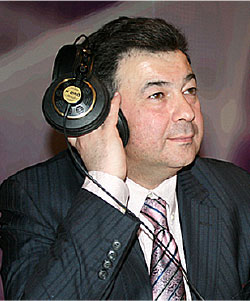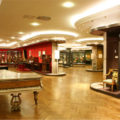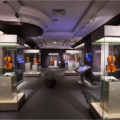The Russian National Museum of Music — Yesterday, Today, Tomorrow
Admire Vrubel’s paintings and Stradivari’s legendary violins, read the cookbook of the renowned Chaliapin, and listen to one of the oldest organs in Russia — all within the walls of the Russian National Museum of Music.
How it Started
In 1912, the Moscow Conservatory opened a museum named after its founder and first director, the virtuoso pianist Nikolay Rubinstein. Over the years, the museum had gradually expanded, increased its staff of researchers, and changed its name to the Central Museum of Musical Culture. In 1943, it was declared a state museum of national importance and was given the name of Mikhail Glinka.
In the beginning of the 1960s, the museum moved to Georgievsky Lane into Troekurovy Chambers, a 17th-century architectural landmark. it could then hold permanent exhibitions, display its extensive collection of musical instruments, and actively carry out educational activities. Two decades later, the museum moved into a new building on Fadeeva Street. Decorated with stained-glass windows resembling a pipe organ and a sculpture of a bell tower, it reminded its visitors of the history of music.
The museum’s rapid expansion started as it incorporated memorial houses and apartments into its complex. in 1995, it was included by the presidential decree in the Russian Cultural Heritage Register, and in 2008, was renamed as the Russian National Museum of Music. it currently comprises the Museum of Music, Golovanov Apartment Museum, Chaliapin House Museum, Tchaikovsky and Moscow Museum, and Prokofiev Museum.
History in Numbers, Colors, and Sounds
Today, the Russian National Museum of Music houses over 800,000 exhibits. It holds a vast collection of autographs, letters, and documents pertaining to the life of great composers, musicians, and singers: Mikhail Glinka, Alexander Alyabyev, Alexander Borodin, Alexander Dargomyzhsky, Pyotr Tchaikovsky, Sergei Rachmaninov, Dmitri Shostakovich, Alexander Scriabin, Feodor Chaliapin, etc. Apart from signature music artefacts, it also has a rich collection of art that includes the paintings by Mikhail Vrubel, Alexander Benois, Boris Kustodiev, Kuzma Petrov-Vodkin, and stage designs by Konstantin Korovin, Ivan Bilibin, Valentin Serov, Nicholas Roerich, and Alexander Golovin.
Particularly remarkable is the museum’s collection of musical instruments, which includes folk instruments from all over the world, mechanical and electronic instruments, sound recording and sound reproducing equipment from the first half of the 20th century. for example, in the Russian National Museum of Music you can hear the oldest organ in Russia. it was made in 1868 in Germany by the master Friedrich Ladegast for the industrialist, philanthropist, and hereditary honorary citizen Vasily Khludov, who regularly hosted musical evenings in his Moscow house. in 1885, an organ class was opened at the Moscow Conservatory. a year later, Khludov, following the example of his friend, publisher Pyotr Jurgenson, donated his home organ to the Conservatory. Since then, the instrument was moved from place to place six times. in 1992, it was taken into the collection of the Russian National Museum of Music. the instrument was badly damaged by unskilled repair and careless storage, and required immediate restoration. After lengthy restoration work, on September 16, 1998, an organ opening concert took place at the Museum of Music. Today, organ concerts here are a regular feature.
The Gem of the Collection
The year 2010 was marked by an important event — the museum acquired the largest state collection of unique string and bow instruments from different countries and eras. A century before, the Soviet People’s Commissar Anatoly Lunacharsky supported the public initiative to create a “fund of unique instruments,” and it is considered to be the year when the State Collection was founded. Musical instruments that used to belong to the royal family, aristocrats, private collectors, and amateur musicians make the core of the collection. It includes string and bow instruments created between the 16th and 20th centuries by such renowned masters as Amati, Stradivari, Guarneri, Bergonzi, etc. And played by the famous musicians: Leonid Kogan, David Oistrakh, Rudolf Barshai, Mstislav Rostropovich, Vladimir Spivakov, Yuri Bashmet, and Vadim Repin.
In 2018, by the President’s order and with the support of the Russian Ministry of Culture, the museum conducted the restoration of a violin made by master Santo Serafin (1749) and a cello by Pietro Guarneri (18th century). Italian conservators carried out large-scale, meticulous work to restore the instruments and recover their superb acoustic characteristics. Today, you can see them at themed exhibitions and hear them during special concert cycles.
Anthem, Universe, Myth
The museum’s current exhibitions showcase modern conceptual principles and technological advances. They serve not only as a center of attraction for tourists and Muscovites but are well-known in the entire international professional musical community.
At the Russian Anthem exhibition, visitors could walk through the stages of the national anthem’s development, witnessing the most important events in the history of the country. At the end of the tour, each visitor could sing the official anthem, joining the largest Russian virtual choir “The Whole Country Sings the Anthem.” in 2016, the exhibition received the Russian Government Award.
Another unique project organized by the museum was called 70 Melodies of Victory. Through watching and listening to archive audio and video materials, the visitors could take a musical journey from pre-war times to the front line, to the camp after a battle, and to the studio of the Radio Committee that broadcasted musical programs all over the world.
Among other significant exhibitions of the Russian National Museum of Music were the interactive SOUND and … Universe. Man. Game project, the Myth of Stradivari exhibition, and the Tchaikovsky Exhibition prepared for the XVI International Tchaikovsky Competition, which was digitalized and uploaded to the Kultura.RF portal so that everyone could use the project materials for educational purposes.

Mikhail Bryzgalov on the air of the Orpheus Radio Station
In 2014, the Orpheus radio station and the Russian National Museum of Music launched a unique media project called Expo Music. Every day, the museum’s director Mikhail Bryzgalov talked on air about the museum’s masterpieces. Over the course of six years, over 300 stories were told for an audience of more than 200 thousand listeners. Since 2019, the Russian National Museum of Music has been holding a series of exhibitions called Masterpieces from the Russian National Museum of Music in collaboration with the Orpheus radio station.
International activity is one of the most important museum’s priorities. the museum actively participates in many international collaborative projects and professional associations: the International Council of Museums (ICOM), Fondazione Stradivari (Italy), the Forum of Slavic Cultures (Slovenia), and the International Association of Music Libraries, Archives and Documentation Centres (IAML). in 2017, the museum received the international Živa Award for the Best Use of Resources.
The museum plays a leading role in the Association of Music Museums and Collections (AMMC) and serves as a methodological center for other museums. Today, the AMMC includes 62 music museums from Russia, Azerbaijan, Belarus, Georgia, Kazakhstan, and Ukraine. Among AMMC’s international partners are the International Committee for Museums and Collections of Instruments and Music (CIMCIM) and the Italian National Association of Houses of Memory.
Ekaterina Kascheeva
Head of Public Relations of the Russian National Museum of Music


